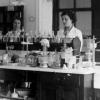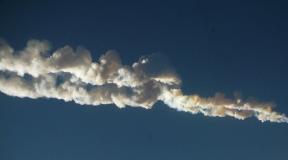Environmental consequences of accidents in chemical production, presentation. Chemical accidents. Basic ways to protect the population from disasters
Hazardous chemicals and objects
A hazardous chemical is a chemical whose direct or indirect exposure to humans can cause acute and chronic illness or death.
emergency chemically hazardous substances; chemical warfare agents; substances that cause predominantly chronic diseases. Types of chemically hazardous substances
Emergency chemically hazardous substances are hazardous chemicals or compounds that, when spilled or released into the environment, can cause injury to people, animals, as well as contamination of air, soil, water, soil, plants and other objects
A chemically hazardous facility (CHF) is an enterprise where, in the event of an accident, massive injuries to people, animals and plants, as well as chemical contamination of the environment, can occur
chemical industry facilities petrochemical industry facilities pulp and paper, textile, food, metallurgical industries, utilities research centers, warehouses (storages) and terminals, vehicles and pipelines. military chemical facilities (warehouses and testing grounds, plants for the destruction of chemical ammunition, special vehicles, warehouses and rocket fuel facilities). non-chemical industry facilities Types of hazardous chemical facilities
Largest consumers Ferrous and non-ferrous metallurgy (chlorine, ammonia, hydrochloric acid, etc.) Pulp and paper industry (chlorine, ammonia, sulfur dioxide, hydrogen sulfide, hydrochloric acid) Mechanical engineering and defense industry (chlorine, ammonia, hydrochloric acid, hydrogen fluoride ) Utilities (chlorine, ammonia) Medical industry (ammonia, chlorine, phosgene, nitrile acrylic acid, hydrochloric acid) Agriculture (ammonia, chloropicrin, sulfur dioxide)
JSC "Kreking" uses sulfuric acid to purify petroleum products
JSC SEPO and other enterprises use ammonia
In the event of an accident at JSC Nitron, the release of 40 tons of chlorine and 645 tons of acrylic acid is possible.
Hazard class and size of sanitary protected zone I class – 1000 m. II class – 500 m. III class – 300 m. IV class – 100 m. V class – 50 m.
REGIONAL TARGET PROGRAM “CHEMICAL AND BIOLOGICAL SAFETY SYSTEM IN THE SARATOV REGION FOR 2010-2013” Saratov, Balashov, Balakovo, Volsk, Engels, Gorny village
Number of chemical enterprises by regions of Russia
Classification of hazardous chemicals All chemicals are divided into four classes: extremely dangerous - hydrogen fluoride, phosphorus oxychloride, ethyleneimine, mercury; highly hazardous - acrolein, hydrogen arsenous, hydrocyanic acid, dimethylamine, carbon disulfide, fluorine, chlorine; moderately hazardous - hydrogen chloride, hydrogen bromide, hydrogen sulfide, trimethylamine; low-hazard - ammonia, methyl acrylate, acetone.
Characteristics of hazardous substances resistance relative density rate of toxic action
A chemically hazardous facility (CHF) is a national economic enterprise, in the event of an accident or destruction of which mass damage to people, animals and plants from highly toxic substances (HAS) can occur. They are used in industry and other sectors; when released (caught), they can lead to air contamination with damaging concentrations. Statistics: In the Russian Federation, there are many chemically hazardous economic facilities that have significant quantities of hazardous chemicals, the total stock of which reaches 700 thousand tons. The total area of the Russian territory where chemical contamination can occur is about 300 thousand square meters. km with a population of about 59 million people

Largest consumers Ferrous and non-ferrous metallurgy (chlorine, ammonia, hydrochloric acid, etc.) Pulp and paper industry (chlorine, ammonia, sulfur dioxide, hydrogen sulfide, hydrochloric acid) Mechanical engineering and defense industry (chlorine, ammonia, hydrochloric acid, hydrogen fluoride ) Utilities (chlorine, ammonia) Medical industry (ammonia, chlorine, phosgene, nitrile acrylic acid, hydrochloric acid) Agriculture (ammonia, chloropicrin, sulfur dioxide)

A chemical contamination zone is a territory contaminated with potent substances within limits dangerous to human life. The source of the lesion is the territory within which, as a result of an accident at a chemically hazardous facility, mass casualties of people, animals, and plants occurred. Toxicity is the property of substances to cause poisoning (intoxication) of the body. Characterized by the dose of a substance that causes one or another degree of poisoning. Toxodosis is a quantitative characteristic of the danger of hazardous substances, corresponding to a certain level of damage when it affects a living organism. For inhalation and skin-resorbital lesions, it is defined differently. Concentration is a quantitative characteristic of a cloud of contaminated air, measured in g / m 3 or mg / l.


Causes of accidents at chemically hazardous facilities (CHF): violation of established norms and rules for the placement of newly constructed and reconstructed chemically hazardous facilities; use of outdated technologies and equipment; an insufficiently high level of labor and production discipline among service personnel: gross violations of labor protection rules during the organization and conduct of loading, unloading and repair work, during transportation and use of hazardous chemicals in the production process; non-compliance with equipment operation rules and erroneous actions of personnel; failure of technological and electrical equipment in areas where hazardous chemicals are used; violations of the technological regime; errors in the design and construction of hazardous chemicals warehouses.

Emergency situations at chemical waste facilities are divided into: as a rule, a small amount of toxic chemical products circulates in the production lines, this leads to the fact that in the event of accidents in the workshops of the enterprise, in most cases, local contamination of the air, equipment, and territory occurs. In such cases, it is mainly production personnel who are affected. Accidents in the workshops of an enterprise, a significantly larger number of hazardous chemicals are contained in warehouses, therefore, when large-capacity containers are destroyed (damaged), hazardous chemicals spread beyond the facility, leading to mass casualties of personnel and the population. Accidents in warehouses; emergency situations during the transportation of hazardous chemicals are associated with a higher degree of danger, since the scale of transportation of these substances is very large. For example: there are more than 700 tanks of liquid chlorine on the railways of the Russian Federation every day. According to data for the years, out of 17 registered accidents with hazardous chemicals, 12 occurred on railways. Transport accidents

According to the experience of eliminating accidents, the most severe consequences with the loss of life were caused by emissions of the following hazardous substances: ammonia chlorine carbon monoxide ethylene oxide hydrogen chloride sulfur dioxide hydrogen cyanide Among these substances, chlorine and ammonia are in first place among cases of loss of life. In recent years, the production and consumption of liquid ammonia at industrial enterprises has increased significantly.

Classification of accidents at chemically hazardous facilities In the chemical industries, accidents are divided into two categories: accidents resulting from explosions that cause destruction of the technological scheme, engineering structures, as a result of which the production of products is completely or partially stopped and special allocations from higher organizations are required for restoration. accidents as a result of which the main or auxiliary technical equipment, engineering structures are damaged, as a result of which the production of products is completely or partially stopped and to restore production requires costs of more than the standard amount for planned major repairs, but special appropriations from higher authorities are not required.

Characteristic features of accidents at chemical waste facilities: the suddenness of the occurrence of an emergency; the rapid spread of damaging factors (especially during emergencies with chemical conditions of the first and second types); the danger of severe mass destruction of people and farm animals caught in the contaminated zone; the need to carry out emergency rescue and other urgent work in a short time.

The following chemical protection measures are carried out in advance: systems for monitoring the chemical situation in areas of chemically hazardous facilities and local warning systems for chemical hazards are created and operated; action plans are developed to prevent and eliminate a chemical accident; Personal protective equipment for respiratory organs and skin, chemical reconnaissance devices, and degassing substances are accumulated, stored and maintained in readiness; shelters are maintained in readiness for use, ensuring the protection of people from hazardous chemicals; measures are being taken to protect food, food raw materials, fodder, and water sources from contamination with hazardous substances; preparation is being carried out for actions in conditions of chemical accidents of emergency rescue units and personnel of chemical organizations; ensures the readiness of forces and assets of subsystems and units of the RSChS, on the territory of which chemically hazardous objects are located, to eliminate the consequences of chemical accidents. systems for monitoring the chemical situation in areas of chemically hazardous facilities and local warning systems for chemical hazards are created and operated; action plans are developed to prevent and eliminate a chemical accident; Personal protective equipment for respiratory organs and skin, chemical reconnaissance devices, and degassing substances are accumulated, stored and maintained in readiness; shelters are maintained in readiness for use, ensuring the protection of people from hazardous chemicals; measures are being taken to protect food, food raw materials, fodder, and water sources from contamination with hazardous substances; preparation is being carried out for actions in conditions of chemical accidents of emergency rescue units and personnel of chemical organizations; ensures the readiness of forces and assets of subsystems and units of the RSChS, on the territory of which chemically hazardous objects are located, to eliminate the consequences of chemical accidents.

Actions upon a signal in case of a chemical accident The safety of the population is ensured by timely notification, the use of individual and collective protective equipment, temporary shelter of people in residential and industrial buildings, and evacuation of the population from areas of possible contamination. The safety of the population is ensured by timely notification, the use of individual and collective protective equipment, temporary shelter of people in residential and industrial buildings, and evacuation of the population from areas of possible infection.

Sometimes it becomes necessary to move around contaminated areas. In this case, the following rules must be followed: When moving, do not drink or eat. After leaving the infected area, you should carry out sanitary treatment. Do not remove personal protective equipment; if toxic substances are found on the skin, clothing and protective equipment, remove them with a paper swab or rag; Do not touch local objects, raise dust or step on liquid spills or powders;

Actions after a chemical accident Avoid any physical activity, drink plenty of fluids and consult a doctor immediately. If you are directly exposed to hazardous substances, then as soon as possible, take off contaminated clothing and throw it away, take a shower (at least 15 minutes), rinse your eyes with a 1% solution of boric acid, wet clean the room and consult a doctor

1 of 28
Presentation - Accidents at chemical facilities
Text of this presentation
Option 1
1. D, F 1. C 2. C 2. B 3. A 3. D 4. B, C 4. A, D, D 5. C, B, F, D, A, E, D 5. A , G, D, F, W
Option 2

Accidents at chemically hazardous facilities and their possible consequences.

Emergency chemically hazardous substance
A chemical substance, the effect of which on a person can cause acute and chronic diseases or even lead to death

Routes of entry of hazardous substances into the human body
Through the eyes
Through the nose
Through the mouth
Through the skin

Largest consumers
Ferrous and non-ferrous metallurgy (chlorine, ammonia, hydrochloric acid, etc.) Pulp and paper industry (chlorine, ammonia, sulfur dioxide, hydrogen sulfide, hydrochloric acid) Engineering and defense industry (chlorine, ammonia, hydrochloric acid, hydrogen fluoride) Utilities economy (chlorine, ammonia) Medical industry (ammonia, chlorine, phosgene, nitrile acrylic acid, hydrochloric acid) Agriculture (ammonia, chloropicrin, sulfur dioxide)

Chemically hazardous facility (CHF)
This is an object, in the event of an accident or its destruction, massive damage to people, animals and plants may occur.

City industries using hazardous chemicals
Metallurgical plant Machine-building plant Confectionery factory Brewery Distillery
Meat processing plant Dairy plant Cold storage plant Utilities Water treatment plants

Chemical accident (CA)
This is an accident at a chemical waste facility, accompanied by a spill or release of hazardous chemicals that can lead to death or chemical contamination of people, food, food raw materials and feed, agricultural animals and plants, or chemical contamination of the natural environment.

Classification
1 group
Substances with a predominantly asphyxiating effect
2nd group
Substances with predominantly general toxic effects
4 group
Substances with asphyxiating and generally toxic effects
5 group
3 group
6 group
Neutropic action
Substances with asphyxiating and neutropic effects
Metabolic poisons


1.Colorless gas, with a sharp suffocating odor of ammonia
Characteristics of hazardous chemicals used in production
AMMONIA
2.Lighter than air
CHLORINE
1. Greenish-yellow gas, with a sharp suffocating smell of bleach
2.Heavier than air

3. Application: - nitric acid - liquid fertilizers - soda - ammonia - for silvering mirrors - as a refrigerant in refrigeration units
4. Signs of poisoning: Irritating the respiratory system, eyes, skin Rapid heartbeat Runny nose Cough Sharp pain in the eyes Nausea Delirium
3. Application: - water chlorination - for plastic production - solvents - disinfectants, bleaches, detergents, glycerin production
4. Signs of poisoning: Sharp pain in the chest Dry cough Vomiting Loss of coordination Shortness of breath Pain in the eyes Tearfulness

5.Protection: -GP of all types -Cotton-gauze bandage soaked in a 2% solution of baking soda 6.Medical assistance: -put on a gas mask Remove from the danger zone Wash the skin with water, apply a bandage for burns Transport in a lying position If breathing stops, perform artificial breath
5.Protection: -GP of all types -Cotton-gauze bandage soaked in a 5% solution of citric acid 6.Medical assistance: -put on a gas mask Take out of the danger zone Wash the skin with water, apply a bandage for burns If breathing stops, perform artificial respiration Rinse eyes Give inhale warm water vapor

Causes:
High level of depreciation of fixed production assets Imperfect production technology Negligence of industrial personnel Lack of modern protection systems Natural disasters

Consequences:
Environmental contamination with hazardous chemicals Massive injury to people Chemical contamination of the ground layer of the atmosphere Contamination of water sources, soil, vegetation

Site of chemical damage
This is an area where a toxic product was spilled.

Protection of the population from hazardous substances

Basic ways to protect the population from hazardous chemicals
Personal respiratory protection (cotton-gauze bandage, respirator, gas mask) Use of protective structures (shelters) Temporary shelter for the population in residential and public buildings Evacuation of the population from areas of possible infection

Protective structures
Asylum
Built-in
Freestanding

Evacuation of the population
On foot
Transport
Combined

Early Actions
Creation of a system and establishment of a procedure for notifying the population
Training of civil and emergency situations management bodies
Preparation of shelters, residential and public buildings for protection from hazardous chemicals
Determination of evacuation areas
Accumulation of protective equipment and determination of the procedure for providing them to people
Preparing the population for protection from hazardous chemicals

Sealing the room
Close entrance doors and windows
Seal the ventilation holes with thick material or paper
Seal the doors with damp material (wet sheet, blanket)
Seal leaks in window openings from the inside with adhesive tape

Rules of conduct in case of accidents with the release of hazardous substances
Turn on the radio or TV listen to information and recommendations Put on respiratory and skin protection Close windows and vents Turn off gas and electricity Take necessary things and documents Take food (3-day supply) Take shelter in the nearest shelter or leave the area of the accident

If there are no shelters and personal protective equipment
Turn on the radio or television and listen to information
Close windows and doors tightly
Seal the room
Cover the entrance doors with thick fabric

What to do when leaving an infected area
Take off your outer clothing
Take a shower with soap
Rinse your eyes thoroughly
Rinse your mouth

When driving in contaminated areas, follow these rules:
Move quickly, but do not run or kick up dust Do not lean against buildings or touch surrounding objects Do not step on drops of liquid or powder of unknown substances encountered in dust Do not remove personal protective equipment Do not eat or drink water

POSSIBLE ANSWERS: 1. TV, radio 2. Respiratory protective equipment 3. Close windows and vents 4. Gas, water, electricity 5. Take necessary things, documents and food 6. Take shelter in the nearest shelter or leave the accident area

Homework Study the textbook material pp. 113-127 Know the groups of hazardous chemicals according to their effects on the human body. Give examples of chemically hazardous facilities and what hazardous chemicals are used in them.
Code for embedding a presentation video player on your website:
Contents Chemical accident Chemical waste facility - a chemically hazardous facility Population in areas of potentially hazardous facilities City enterprises using hazardous chemicals Chemical hazardous substances - emergency chemically hazardous substances Consequences of accidents at chemically hazardous facilities Actions of the population upon notification of a chemical accident Actions after leaving the zone of chemical contamination


CHO – chemically hazardous facility A chemically hazardous facility (CHF) is a facility where hazardous chemicals are stored, processed, used or transported, and in the event of an accident, loss of life or chemical contamination of the environment may occur.



Urban industries using hazardous chemicals Metallurgical plant Engineering plant Confectionery factory Brewery Distillery Meat processing plant Dairy plant Cold storage plant Utilities Water treatment plants

Chlorine Chlorine is a greenish-yellow gas with a pungent, suffocating odor, heavier than air. Spreads along the ground. Effect on humans: irritation of mucous membranes, skin, sharp pain in the chest, cough, shortness of breath, vomiting, pain in the eyes, impaired coordination of movement Protection: civil gas mask, cotton-gauze bandage moistened with a 2% solution of baking soda, raincoat Put on the victim for first aid gas mask, take it out of the danger zone, create rest, give warm drink, in case of contact with skin, wash with water, in case of a burn, apply an aseptic bandage, if breathing stops, perform artificial respiration

Ammonia Ammonia is a colorless gas with a pungent suffocating odor, lighter than air. Penetrates the upper floors of buildings. Effect on humans: irritation of mucous membranes, skin, itching, redness, runny nose, cough, suffocation, palpitations Protection: civil gas mask, cotton-gauze bandage moistened with a 5% solution of citric acid, First aid: put a gas mask on the victim, take him out of the danger zone, give inhale warm water vapor with the addition of vinegar, rinse eyes, in case of contact with skin, rinse with water, in case of a burn, apply an aseptic bandage, if breathing stops, perform artificial respiration

Read also...
- Artistic culture of the period of “stagnation” Presentations on the topic of culture of stagnation in the USSR
- Do you know how a message about the chemical element francium
- Development of a lesson on the history of Russia: “Culture and spiritual climate in the era of “stagnation” Soviet cultures during the years of stagnation presentation
- Presentation on the topic "Medieval chivalry"



















